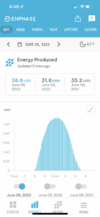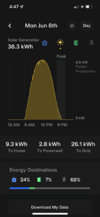In my case Tesla reports PV production that is typically 5% higher than Enphase readings and consumption that is 10% higher than Enphase. Unfortunately my grid voltage is a bit too hot. Most of the time it is 248V-249V. I speculate that Tesla calculations include voltage in calculations while Enphase is using 240V nominal voltage.I also have enphase micros (and an enphase envoy) feeding Tesla gateway/Powerwalls.
I’m curious if your Tesla CT and Enphase CT measure the same energy/power. In my experience Tesla will report 10% more solar generation compared to enphase.
For example on a given day, Tesla could say I generate 33 kWh of power.
When I log into Enphase / enlighten it will say my solar production is 30 kWh.
I’m just curious if you also see reporting discrepancy between the two ecosystems.
I also have GE RGM for PV production. One day I will compare aggregate RGM power difference for one day to figure out if Tesla or Enphase readings are closer to reality.




